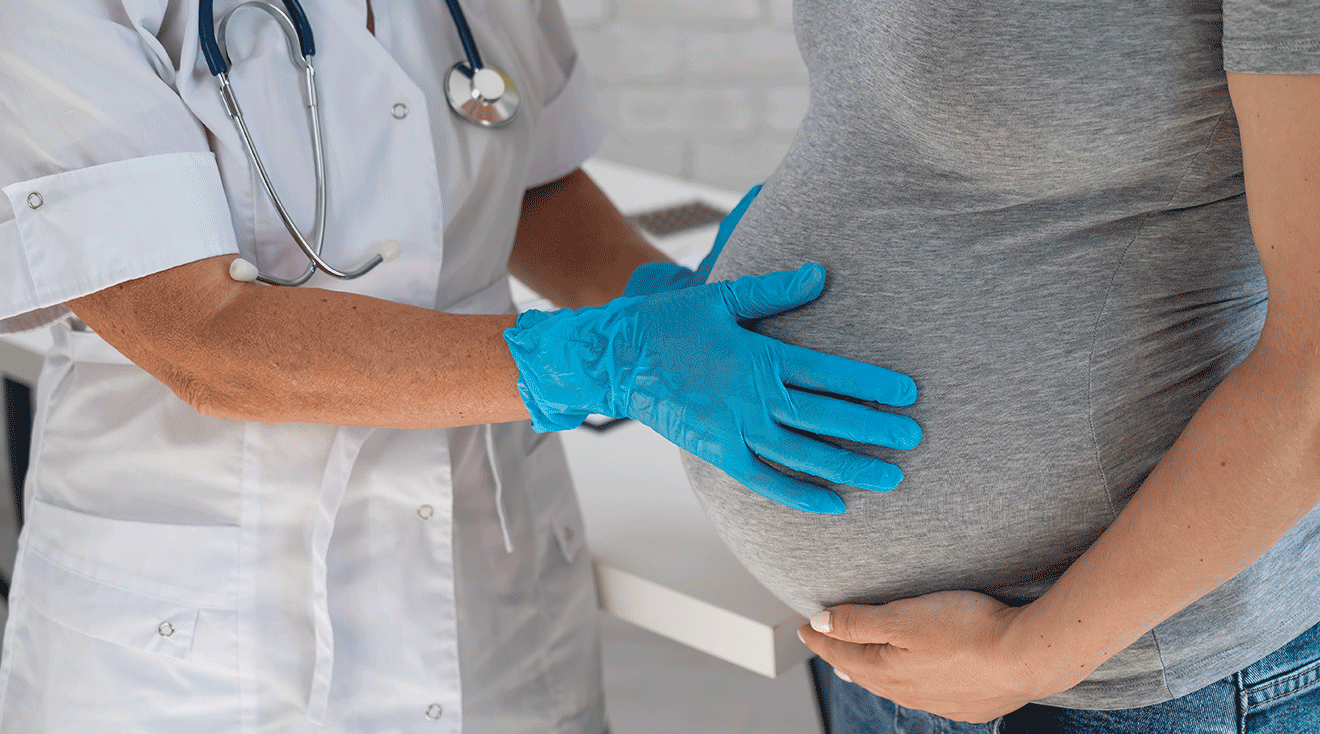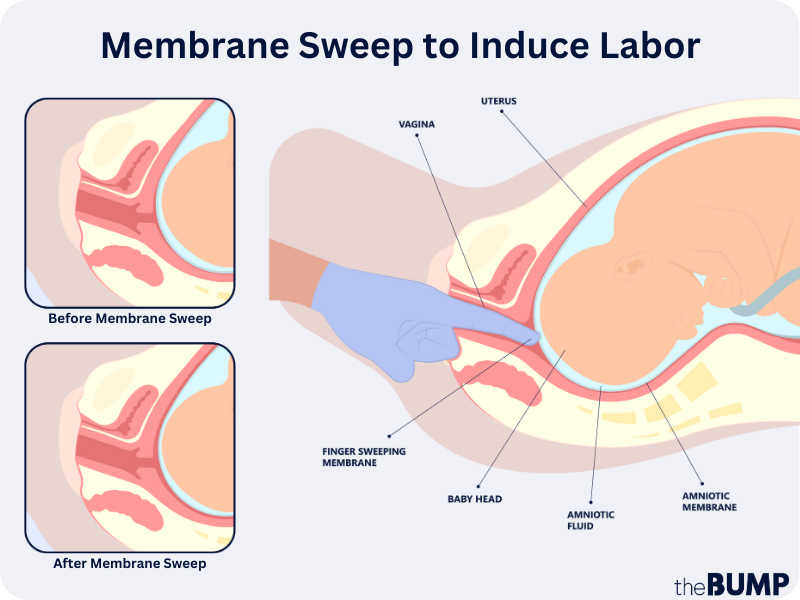What Is a Membrane Sweep—and How Can It Induce Labor?
By the time you reach those final days of pregnancy, you might be willing to try just about anything to encourage baby to (finally!) make their grand entrance. If you’re looking to avoid a medical labor induction, you might have considered natural ways to induce labor, such as eating spicy food, taking a brisk walk or having plenty of sex. (Keep in mind that none of these are surefire ways to speed labor along, of course!) A more reliable option that doesn’t rely on myths or medication is having your provider perform a membrane sweep. Keep reading to learn how stripping membranes (otherwise known as a sweep of the membranes) can help kickstart labor, what to expect from the procedure and more.
A membrane sweep, also known as stripping the membranes, is a procedure your doctor might offer around 39 to 40 weeks of pregnancy in order to help induce labor without using medication, says Cleveland Clinic. Your provider will sweep their finger across the membranes that connect your amniotic sac to the wall of your uterus, which helps release chemicals called prostaglandins that prepare your body for labor. The procedure has to be performed once your cervix has already started to dilate.
How is a membrane sweep done?
During a membrane sweep, your provider will “sweep” a gloved finger around the cervix in a circular motion between your amniotic membrane and the lowest part of your uterus, says Melissa Dennis, MD, MHA, FACOG, an ob-gyn in Chicago and chief medical officer for Partum Health. This can be done during a vaginal exam.
Once your pregnancy reaches full term, your doctor might recommend a membrane sweep as a way to get labor going faster without using medication. “It can be suggested in patients that are going to deliver vaginally and are 39 weeks or greater in the hopes of increasing the chances that the patient may go into labor,” says Joseph A. Adashek, MD, FACOG, an ob-gyn in Las Vegas and associate clinical professor of maternal-fetal medicine at the University of Nevada School of Medicine.
Performing a sweep of membranes is generally considered to be safe, Dennis says. The only exception is if you’re positive for group B strep during pregnancy, a bacteria that’s harmless to you but could present a danger to baby. In that case, you may face a potential increased risk of infection, so your provider may or may not be comfortable with sweeping your membranes, Dennis says.
While there’s not a ton of data on the efficacy of the membrane sweep procedure, there’s definitely research to suggest it works, experts say. Of course, experiences vary person to person. For some, they don’t quite work right away: “With my first pregnancy, I had two membrane sweeps: one at 39 weeks and a second at 40 weeks. The first one resulted in a lot of cramping for about 24 hours, but didn’t start labor,” says Gennifer, a mom of two.
For others, they work quickly: “Two days before my due date, we went to the doctor’s office at about 9:30 a.m. I had a membrane sweep, and was back in the office by 12:30 that afternoon with pain and contractions! Baby was delivered around 8 p.m. that same night,” says Samantha, a mom of one.
Membrane sweep success rate
A review of available studies showed that pregnant women who have their membranes swept had a “decreased duration of their pregnancy and a reduced frequency of pregnancy continuing beyond 41 weeks” when compared to those who didn’t have membrane sweeps, says Dennis.
One study showed that patients who had weekly membrane sweeps starting at 38 weeks had a 90 percent chance of going into labor spontaneously before 41 weeks, while those who didn’t have membrane sweeps had a 75 percent chance.
Further, a 2023 study concluded that membrane sweeping to induce labor has a high success rate with a low rate of maternal and fetal complications.
Membrane sweeps are generally safe, but there’s a chance you’ll bleed afterward. Dennis says you can also expect some discomfort and cramping. According to Cleveland Clinic, there’s a small chance a membrane sweep will result in your water breaking, aka rupturing of the amniotic sac, which has its own set of risks.
For about 24 hours after a membrane sweep, you might experience the following symptoms, says Dennis:
- Discomfort
- Cramping
- Irregular contractions
- Light vaginal bleeding
“If you’re bleeding as heavily as a period, your water breaks or you think you’re in labor, make sure to contact your provider,” Dennis says.
Signs of a successful membrane sweep
“If your cramping or irregular contractions build into painful, regular contractions, you’ll know the membrane sweeping was successful,” Dennis says. And even if the membrane sweep doesn’t kickstart the “main event,” all the cramping and contractions can still help make your cervix softer and more dilated in preparation for labor, she says.
How long after a membrane sweep does labor start?
With a successful membrane sweep, you can expect to be in labor within about two days. “If membrane sweeping is going to be successful, labor will often happen within 48 hours of having it done,” Dennis says. However, if it doesn’t work, don’t despair: A membrane sweep can still help your body prepare for labor by ripening the cervix.
Frequently Asked Questions
Is a membrane sweep or membrane stripping painful?
Like many things related to pregnancy, membrane sweeping isn’t amazingly comfortable. You might feel quite a bit of pressure during the procedure. “Some will experience pressure and some pain,” says Dennis. “Most don’t find it comfortable. If, at any point, you need your provider to stop, speak up.”
How dilated do you need to be to have a membrane sweep?
In order for your provider to perform a membrane sweep, your cervix will need to have started dilating on its own. According to Adashek, “the cervix has to be dilated enough to fit one or two fingers through the entire portion of [it].” This means it should be at least 1 to 2 centimeters dilated, he says.
Can you have a membrane sweep more than once if it doesn’t work the first time?
Your provider can repeat a membrane sweep if it’s unsuccessful the first time, Dennis says. “There’s no increased risk with multiple sweeps.”
Can you do a membrane sweep yourself at home?
Simply put, no. “While there are some things you can try at home to stimulate labor, sweeping your membranes is not one of them,” says Dennis. “This is something that needs to be done by your OB or midwife at the time of a cervical exam.” Adashek adds: “You would have to be a gymnast with some super-long fingers to do this. It’s challenging enough to perform it on a patient, but a whole new level of challenging to perform it on yourself.” Suffice it to say, it’s simply not safe.
If you’re looking to get labor going faster but want to avoid a medical induction, ask your provider whether stripping membranes—or having a membrane sweep—could be the right option for you.
Please note: The Bump and the materials and information it contains are not intended to, and do not constitute, medical or other health advice or diagnosis and should not be used as such. You should always consult with a qualified physician or health professional about your specific circumstances.
Plus, more from The Bump:
Joseph A. Adashek, MD, FACOG, is an ob-gyn in Las Vegas and an associate clinical professor of maternal-fetal medicine at the University of Nevada School of Medicine. He earned his medical degree from Penn State College of Medicine.
Melissa Dennis, MD, MHA, FACOG, is an ob-gyn in Chicago and chief medical officer for Partum Health. She received her medical degree from University of Missouri-Kansas City School of Medicine.
Cleveland Clinic, Membrane Sweep, October 2021
Cochrane Library, Membrane Sweeping for Induction of Labour, April 2001
Journal of Clinical Gynecology & Obstetrics, The Efficacy of Membrane Sweeping at Term and Effect on the Duration of Pregnancy: A Randomized Controlled Trial, February 2014
Cureus, Membrane Sweeping to Induce Labor in Post-term Pregnant Women: Success Rate and Outcomes, March 2023
Learn how we ensure the accuracy of our content through our editorial and medical review process.
Navigate forward to interact with the calendar and select a date. Press the question mark key to get the keyboard shortcuts for changing dates.





















































